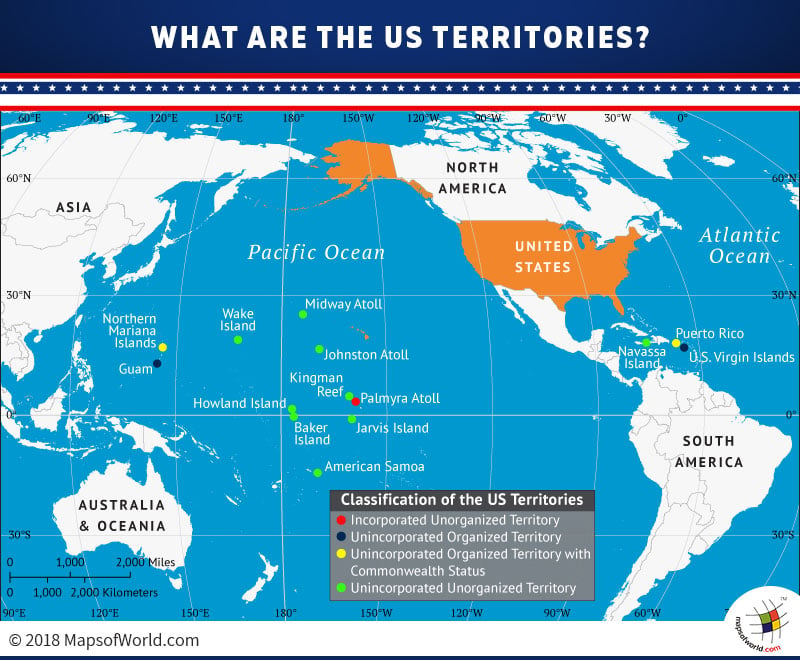What are the US territories?
There are 16 overseas territories of the United States. Of these, five territories are classified as inhabited, while the remaining eleven are classified as uninhabited or without a permanent population.
Territories are defined as land acquired by the United States but not claimed by any of the 50 states. The overall territorial security, economic development, and social support lie with the federal government, with local administration governing under laws passed by the respective legislature in the territories.
U.S. territories have lesser political powers as compared to U.S. Commonwealths. Puerto Rico and the Northern Mariana Islands are two of the U.S. insular areas that are also part of the U.S. Commonwealth.
The five overseas U.S. territories are:
- Status: Unincorporated and organized
- Location: the Caribbean and North Atlantic
- Area: 3,515 sq miles (9,104 sq km)
- Population: 3,667,084
- Capital: San Juan
- Largest Town: San Juan
- Status: Unincorporated and organized
- Location: Micronesia and North Pacific
- Area: 210 sq miles (543 sq km)
- Population: 159,358
- Capital: Hagatna
- Largest Town: Dededo
United States Virgin Islands
- Status: Unincorporated and organized
- Location: the Caribbean and North Atlantic
- Area: 134 sq miles (346.36 km)
- Population: 106,405
- Capital: Charlotte Amalie
- Largest Town: Charlotte Amalie
Northern Mariana Islands
- Status: Unincorporated and organized
- Location: Micronesia and North Pacific
- Area: 179 sq miles (463.63 sq km)
- Population: 77,000
- Capital: Capitol Hill, Saipan
- Largest Town: Garapan
American Samoa
- Status: Unincorporated and unorganized
- Location: Polynesia and South Pacific
- Area: 76.10 sq miles (197.10 km)
- Population: 55,519
- Capital: Pago Pago
- Largest Town: Tafuna
Of the above territories, only residents of American Samoa are classified as non-citizens U.S. nationals.
The eleven territories that are uninhabited or without a permanent population comprise small islands, atolls, and reefs.
Midway Atoll
- Status: Unincorporated and unorganized
- Location: North Pacific
- Area: 2.40 sq miles (6.20 km)
- Population: 60
Palmyra Atoll
- Status: Incorporated and unorganized
- Location: North Pacific and Polynesia
- Area: 5 sq miles (12 sq km)
- Population: 5-20
Baker Island
- Status: Unincorporated and unorganized
- Location: North Pacific
- Area: 0.81 sq miles (2.10 sq km)
- Population: 0
Kingman Reef
- Status: Unincorporated and unorganized
- Location: North Pacific and Polynesia
- Area: 6.90 sq miles (18 sq km)
- Population: 0
Johnston Atoll
- Status: Unincorporated and unorganized
- Location: North Pacific
- Area: 1.03 sq miles (2.67 sq km)
- Population: 0
Howland Island
- Status: Unincorporated and unorganized
- Location: North Pacific
- Area: 1.70 sq miles (4.50 sq km)
- Population: 0
Navassa Island
- Status: Unincorporated and unorganized
- Location: the Caribbean and North Atlantic
- Area: 2.10 sq miles (5.40 sq km)
- Population: 0
Jarvis Island
- Status: Unincorporated and unorganized
- Location: South Pacific and Polynesia
- Area: 1.83 sq miles (4.75 sq km)
- Population:
Wake Island
- Status: Unincorporated and unorganized
- Location: North Pacific and Micronesia
- Area: 2.90 sq miles (7.40 km)
- Population: 0
Bajo Nuevo Bank
- Status: Unincorporated and unorganized
- Location: the Caribbean and North Atlantic
- Area: 42 sq miles (110 sq km)
- Population: 0
Serranilla Bank
- Status: Unincorporated and unorganized
- Location: the Caribbean and North Atlantic
- Area: 140 sq miles (350 sq km)
- Population: 0
Of the eleven territories above, Serranilla Bank and Bajo Nuevo Bank are administered by Colombia. Palmyra Atoll is the only incorporated unorganized territory of the U.S. Since it remains uninhabited its status is of little significance. The Atoll was acquired by the U.S. as part of the acquisition process of the chain of Hawaiian islands. At the time, Palmyra Atoll was not made part of the Hawaiian statehood, so, it was made an incorporated territory.
Political and Administrative Status
People living in U.S. territories do not have the right to vote for members of Congress. Each of the five inhabited U.S. territories is headed by a Governor and with a locally elected legislature passing laws. The court comes under U.S. law, and all appeals are heard in the Supreme Court.
Each territory sends one delegate to the House of Representatives to represent local interests. The Representative is a non-voting delegate who can participate in all House debates, raise any issue, and participate in various Sub-Committees, but cannot vote to elect the U.S. President nor vote during the passage of Bills in the House. The rights enjoyed by the delegate from overseas territories are similar to the delegate from Washington D.C., the capital of the United States and a territory.
Visit the following to learn more about the USA:
Related Maps:



